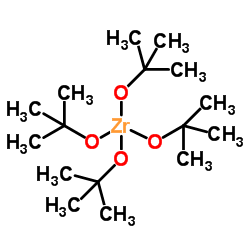2081-12-1
| Name | zirconium(iv) tert-butoxide |
|---|---|
| Synonyms |
Zirconium(4+) tetrakis(2-methyl-2-propanolate)
ZIRKONIUM(IV) TERT-BUTOXIDE Zirconium tert-butanolate Tetra-tert-butoxyzirconium,Tetra-tert-butyl zirconate,ZTB ZIRKON(IV)-TERT-BUTOXID zirconium tetra(tert-butoxide) MFCD00075085 ZIRCONIUM TETRA-T-BUTOXIDE ZIRCONIUM T-BUTOXIDE zirconium tetrabutoxide ZIRCONIUM(IV)T-BUTOXIDE zirconium tert-butoxide Tetra-tert-butoxyzirconium Zr(tert-butoxide)4 Zirconium(4+) tetrakis(2-methylpropan-2-olate) TETRA-TERT-BUTYL ZIRCONATE 2-Propanol, 2-methyl-, zirconium(4+) salt (4:1) |
| Density | 0.985 g/mL at 25 °C(lit.) |
|---|---|
| Boiling Point | 81 °C3 mm Hg(lit.) |
| Melting Point | 3°C |
| Molecular Formula | C16H36O4Zr |
| Molecular Weight | 383.679 |
| Flash Point | 185 °F |
| Exact Mass | 382.166077 |
| PSA | 36.92000 |
| LogP | 5.06320 |
| Index of Refraction | n20/D 1.424(lit.) |
| Storage condition | 2-8°C |
|
Section 1: Product Identification Chemical Name:Zirconium (IV) t-butoxide, 99% CAS Registry Number:2081-12-1 Formula:Zr(OC4H9)4 EINECS Number: Chemical Family:metal alkoxide Synonym:zirconium t-butylate; t-butanol, zirconium salt.
Section 2: Composition and Information on Ingredients IngredientCAS NumberPercentACGIH (TWA)OSHA (PEL) Title Compound2081-12-1100%5mg/m3 (as Zr)5mg/m3 (as Zr) Section 3: Hazards Identification Emergency Overview:Irritating to the respiratory tract, skin and eyes. May be harmful if swallowed. Primary Routes of Exposure:Inhalation, ingestion, contact with skin and eyes. Eye Contact:Causes slight to mild irritation of the eyes Skin Contact:Causes slight to mild irritation of the skin. Inhalation:Irritating to skin, eyes and respiratory tract. Ingestion:Ingestion may cause gastrointestinal distress, nausea, vomiting and headache. Acute Health Affects:Irritating to skin, eyes and respiratory tract. No data is available for this product. In animal studies, t-butanol in high doses has acted as a reproductive Chronic Health Affects: effector. NTP:No IARC:No OSHA:No SECTION 4: First Aid Measures Immediately flush the eyes with copious amounts of water for at least 10-15 minutes. A victim may need Eye Exposure: assistance in keeping their eye lids open. Get immediate medical attention. Wash the affected area with soap and water. Remove contaminated clothes if necessary. Seek medical Skin Exposure: assistance if irritation persists. Remove the victim to fresh air. Closely monitor the victim for signs of respiratory problems, such as difficulty Inhalation: in breathing, coughing, wheezing, or pain. In such cases seek immediate medical assistance. Ingestion:Seek medical attention immediately. Keep the victim calm. Give the victim water (only if conscious). SECTION 5: Fire Fighting Measures Flash Point:185 °F Autoignition Temperature:no data Explosion Limits:no data Extinguishing Medium:carbon dioxide, dry powder or foam If involved in a fire, fire fighters should be equipped with a NIOSH approved positive pressure self-contained Special Fire Fighting Procedures: breathing apparatus and full protective clothing. Hazardous Combustion andIf involved in a fire this material may emit toxic organic fumes and zirconia dust. Decomposion Products: Unusual Fire or Explosion Hazards: Combustible. No unusual fire or explosion hazards. SECTION 6: Accidental Release Measures Avoid contact with water. Small spills may be adsorbed into diatomaceous earth, sand, or other suitable Spill and Leak Procedures: adsorbent, and swept up. SECTION 7: Handling and Storage Store in a tightly sealed container in a dry place. If container is left open, product may adsorb moisture from Handling and Storage: the atmosphere and release t-butanol vapor. SECTION 8: Exposure Controls and Personal Protection Eye Protection:Always wear approved safety glasses when handling a chemical substance in the laboratory. Skin Protection:Wear protective clothing and gloves. Ventilation:Material may form a vapor upon exposure to air. if possible, handle the material in an efficient fume hood. If ventilation is not available a respirator should be worn. The use of respirators requires a Respirator Respirator: Protection Program to be in compliance with 29 CFR 1910.134. Ventilation:Material may form a vapor upon exposure to air. if possible, handle the material in an efficient fume hood. Additional Protection:No additional protection required. SECTION 9: Physical and Chemical Properties Color and Form:slightly yellow liq. Molecular Weight:383.68 Melting Point:no data Boiling Point:90°C /5 mm Vapor Pressure:no data Specific Gravity:0.96 Odor:sweet odor Solubility in Water:reacts with water SECTION 10: Stability and Reactivity Stability:moisture sensitive liquid, (store cold) Hazardous Polymerization:no hazardous polymerization Conditions to Avoid:contact with moisture Incompatibility:halogens Decomposition Products:Carbon dioxide, carbon monoxide, organic vapors, and metal oxides and carbonates. SECTION 11: Toxicological Information No information available in the RTECS files. t-butanol, hydrolysis product: skin (rbt) Draize: 500 ul/24h mild; RTECS Data:eye (rbt) Draize 100 ul/24h: severe; oral (rat) LD50: 2743 mg/kg; inhalation (rat) LC50: >10000 ppm/4h; Intraperitoneal (mouse) LD50: 399 mg/kg. oral (rbt) LD50: 3559 mg/kg; inhalation (rat) TCLo (reprod): 2000. Carcinogenic Effects:No data available Mutagenic Effects:No data available Tetratogenic Effects:No data available SECTION 12: Ecological Information Ecological Information:No information available SECTION 13: Disposal Considerations Disposal:Dispose of according to local, state and federal regulations. SECTION 14: Transportation Shipping Name (CFR):Non-hazardous Hazard Class (CFR):NA Additional Hazard Class (CFR):NA Packaging Group (CFR):NA UN ID Number (CFR):NA Shipping Name (IATA):Non-hazardous Hazard Class (IATA):NA Additional Hazard Class (IATA):NA Packaging Group (IATA):NA UN ID Number (IATA):NA SECTION 15: Regulatory Information TSCA:Not listed in the TSCA inventory. SARA (Title 313):Title compound not listed. Second Ingredient:none SECTION 16 - ADDITIONAL INFORMATION N/A |
| Symbol |

GHS07 |
|---|---|
| Signal Word | Warning |
| Hazard Statements | H315-H319-H335 |
| Precautionary Statements | P261-P305 + P351 + P338 |
| Personal Protective Equipment | Eyeshields;full-face respirator (US);Gloves;multi-purpose combination respirator cartridge (US);type ABEK (EN14387) respirator filter |
| Hazard Codes | Xi: Irritant; |
| Risk Phrases | R36/37/38 |
| Safety Phrases | S26-S36 |
| RIDADR | 1993 |
| WGK Germany | 3 |
| Packaging Group | III |
| Hazard Class | 3 |
| HS Code | 2909199090 |
| HS Code | 2909199090 |
|---|---|
| Summary | 2909199090. other acyclic ethers and their halogenated, sulphonated, nitrated or nitrosated derivatives. VAT:17.0%. Tax rebate rate:13.0%. . MFN tariff:5.5%. General tariff:30.0% |
